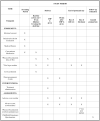Study protocol for the BUSCopan in LABor (BUSCLAB) study: A randomized placebo-controlled trial investigating the effect of butylscopolamine bromide to prevent prolonged labor
- PMID: 36327275
- PMCID: PMC9632812
- DOI: 10.1371/journal.pone.0276613
Study protocol for the BUSCopan in LABor (BUSCLAB) study: A randomized placebo-controlled trial investigating the effect of butylscopolamine bromide to prevent prolonged labor
Abstract
Background: First-time mothers are prone to prolonged labor, defined as the crossing of partograph alert or action lines. Prolonged labor may occur among as many as one out of five women, and is associated with a range of adverse birth outcomes. Oxytocin is the standard treatment for prolonged labor, but has a narrow therapeutic window, several adverse effects and limited efficacy. Despite poor evidence, labor wards often use antispasmodic agents to treat prolonged labor. The antispasmodic drug butylscopolamine bromide (Buscopan®) may shorten duration of labor, but studies on prevention of prolonged labor are lacking. In this randomized double-blind placebo-controlled clinical trial, we aim to evaluate the effect of butylscopolamine bromide on duration of labor in first-time mothers showing first signs of slow labor progress by crossing the World Health Organization partograph alert line.
Methods and analysis: The study is a single center study at Oslo University Hospital, Oslo, Norway. We will recruit 250 primiparous women with spontaneous labor start at term. Women are included in the first stage of labor if they show signs of slow labor progress, defined as the crossing of the partograph alert line with a cervical dilation between 3-9 cm. Participants are randomized 1:1 to either 20 mg intravenous butylscopolamine bromide or intravenous placebo (1 mL sodium chlorine 9 mg/mL). We considered a mean difference of 60 minutes in labor duration clinically relevant. The primary outcome is duration of labor from the provision of the investigational medicinal product to vaginal delivery. The secondary outcomes include change in labor pain, use of oxytocin augmentation, delivery mode, and maternal birth experience. The primary data for the statistical analysis will be the full analysis set and will occur on completion of the study as per the prespecified statistical analysis plan. The primary outcome will be analyzed using Weibull regression, and we will treat cesarean delivery as a censoring event.
Conflict of interest statement
The authors have declared that no competing interests exists.
Figures


Similar articles
-
The effect of intravenous hyoscine butylbromide on slow progress in labor (BUSCLAB): A double-blind randomized placebo-controlled trial.PLoS Med. 2024 Mar 28;21(3):e1004352. doi: 10.1371/journal.pmed.1004352. eCollection 2024 Mar. PLoS Med. 2024. PMID: 38547322 Free PMC article. Clinical Trial.
-
Effect of partograph use on outcomes for women in spontaneous labour at term and their babies.Cochrane Database Syst Rev. 2018 Aug 6;8(8):CD005461. doi: 10.1002/14651858.CD005461.pub5. Cochrane Database Syst Rev. 2018. PMID: 30080256 Free PMC article.
-
Randomized controlled trial of labor outcomes with action line placement at 2 hours versus 4 hours on the partograph.Int J Gynaecol Obstet. 2020 Jul;150(1):64-71. doi: 10.1002/ijgo.13144. Epub 2020 Apr 17. Int J Gynaecol Obstet. 2020. PMID: 32301113 Clinical Trial.
-
Comparing Different Partograph Designs for Use in Standard Labor Care: A Pilot Randomized Trial.Matern Child Health J. 2018 Mar;22(3):355-363. doi: 10.1007/s10995-017-2366-0. Matern Child Health J. 2018. PMID: 28936715 Clinical Trial.
-
Efficacy of hyoscine butyl-bromide in shortening the active phase of labor: Systematic review and meta-analysis of randomized trials.Eur J Obstet Gynecol Reprod Biol. 2020 Sep;252:218-224. doi: 10.1016/j.ejogrb.2020.06.042. Epub 2020 Jun 23. Eur J Obstet Gynecol Reprod Biol. 2020. PMID: 32629224
Cited by
-
The effect of intravenous hyoscine butylbromide on slow progress in labor (BUSCLAB): A double-blind randomized placebo-controlled trial.PLoS Med. 2024 Mar 28;21(3):e1004352. doi: 10.1371/journal.pmed.1004352. eCollection 2024 Mar. PLoS Med. 2024. PMID: 38547322 Free PMC article. Clinical Trial.
References
-
- Le Ray C, Fraser W, Rozenberg P, Langer B, Subtil D, Goffinet F, et al.. Duration of passive and active phases of the second stage of labour and risk of severe postpartum haemorrhage in low-risk nulliparous women. Eur J Obstet Gynecol Reprod Biol. 2011;158(2):167–72. doi: 10.1016/j.ejogrb.2011.04.035 - DOI - PubMed
Publication types
MeSH terms
Substances
LinkOut - more resources
Full Text Sources
Medical

